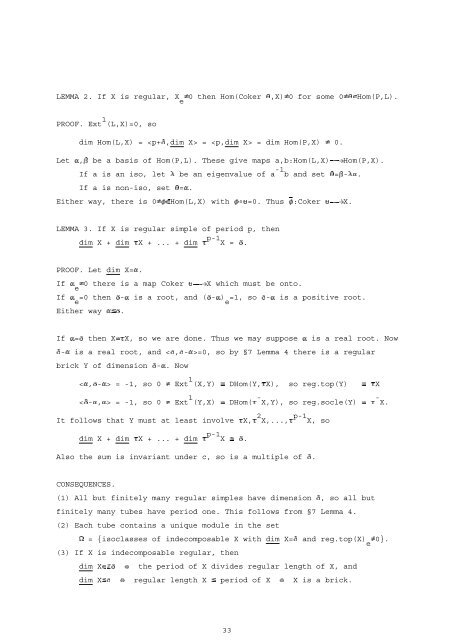Lectures on Representations of Quivers by William Crawley-Boevey ...
Lectures on Representations of Quivers by William Crawley-Boevey ...
Lectures on Representations of Quivers by William Crawley-Boevey ...
Create successful ePaper yourself
Turn your PDF publications into a flip-book with our unique Google optimized e-Paper software.
LEMMA 2. If X is regular, X £ 0 then Hom(Coker ¤ ,X)£ 0 for some 0£ ¤ ¡ Hom(P,L).<br />
e<br />
1<br />
PROOF. Ext (L,X)=0, so<br />
dim Hom(L,X) = = = dim Hom(P,X) £ 0.<br />
¤ ¡ ¡ ,¥<br />
=¥ ¤ ¤<br />
Let be a basis <strong>of</strong> Hom(P,L). These give maps a,b:Hom(L,X) Hom(P,X).<br />
If a is an iso, let<br />
-1<br />
be an eigenvalue <strong>of</strong> a b and set - .<br />
If a is n<strong>on</strong>-iso, set ¤ =¤ .<br />
Either way, there is 0£ § ¡ Hom(L,X) with §©¦¤ =0. Thus § :Coker ¤¦ ¡ X.<br />
LEMMA 3. If X is regular simple <strong>of</strong> period p, then<br />
dim X + dim X + ... + dim<br />
p-1<br />
X = § .<br />
PROOF. Let dim X=¤ .<br />
If ¤ £ 0 there is a map Coker ¤¦ ¡ X which must be <strong>on</strong>to.<br />
e<br />
If ¤ =0 then § -¤ is a root, and ( § -¤ ) =1, so § -¤ is a positive root.<br />
e e<br />
Either way ¤¦¤ § .<br />
If ¤ = § then X X, so we are d<strong>on</strong>e. Thus we may suppose ¤ is a real root. Now<br />
§ -¤ is a real root, and < § , § -¤ >=0, so <strong>by</strong> §7 Lemma 4 there is a regular<br />
brick Y <strong>of</strong> dimensi<strong>on</strong> § -¤ . Now<br />
1<br />
, = -1, so £ 0 Ext (X,Y) DHom(Y, X), so reg.top(Y) -¤ X<br />
<<br />
1 - -<br />
§ -¤ £ ,¤ > = -1, so 0 Ext (Y,X) DHom( X,Y), so reg.socle(Y) X.<br />
2 p-1<br />
It follows that Y must at least involve X, X,..., X, so<br />
dim X + dim X + ... + dim<br />
p-1 ¤ §<br />
X .<br />
Also the sum is invariant under c, so is a multiple <strong>of</strong> § .<br />
CONSEQUENCES.<br />
(1) All but finitely many regular simples have dimensi<strong>on</strong> § , so all but<br />
finitely many tubes have period <strong>on</strong>e. This follows from §7 Lemma 4.<br />
(2) Each tube c<strong>on</strong>tains a unique module in the set<br />
= {isoclasses <strong>of</strong> indecomposable X with dim X= § and reg.top(X) £ 0}.<br />
e<br />
(3) If X is indecomposable regular, then<br />
dim X¡ ¦ § the period <strong>of</strong> X divides regular length <strong>of</strong> X, and<br />
dim X¤ § regular length X ¤ period <strong>of</strong> X X is a brick.<br />
33<br />
¡

















